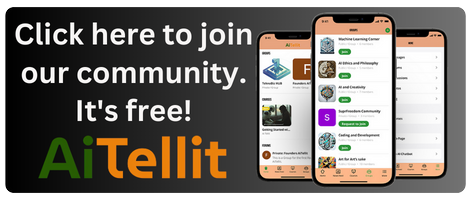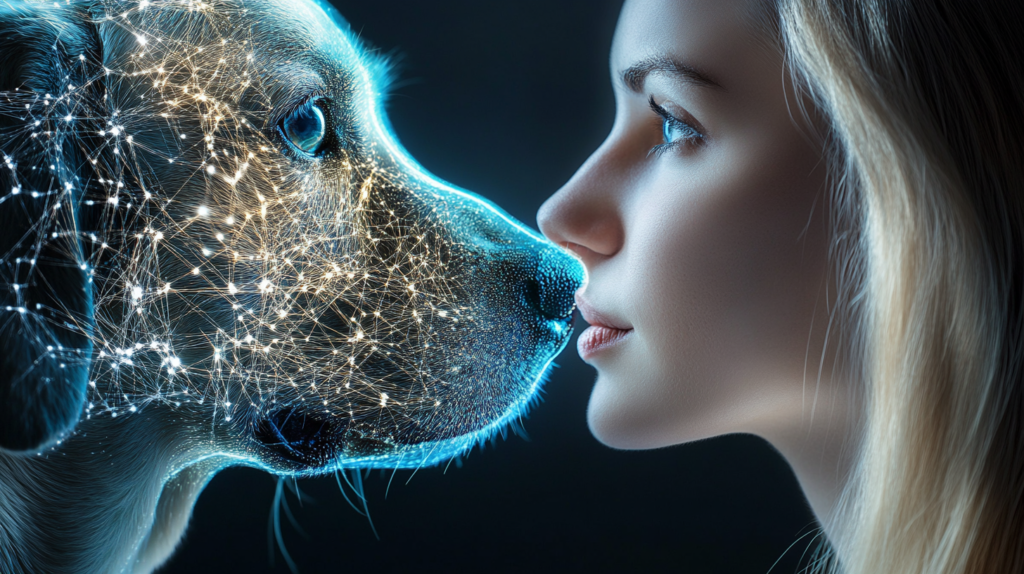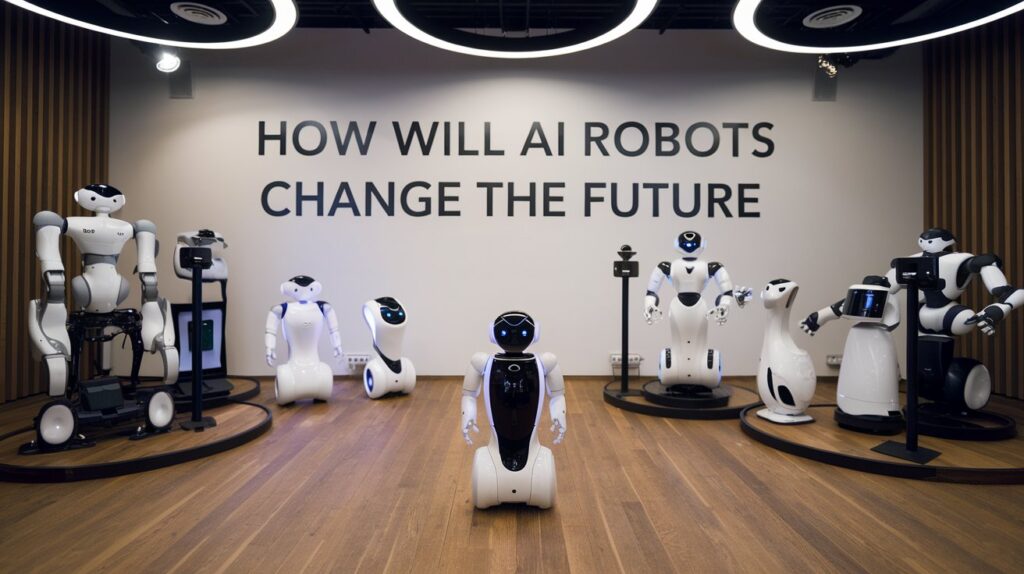Can We Soon Use AI to Talk to Our Pets and Other Animals?

You might have noticed how AI is making strides in interpreting animal sounds, with innovations like DeepSqueak and MeowTalk showing promise. These tools could soon bridge the gap between humans and their pets, revealing emotions and intentions previously lost in translation. As machine learning continues to evolve, the potential for genuine dialogue with animals seems closer than ever. But before we get too optimistic, there are ethical considerations and implications that warrant a closer look. What might it really mean to understand our pets on this level?
Can We Soon Use AI to Talk to Our Pets and Other Animals audio file

Key Takeaways
- AI tools like MeowTalk and DeepSqueak are already interpreting animal vocalizations, enabling basic communication with pets like cats and rodents.
- Advanced machine learning techniques can analyze animal sounds to predict emotional responses, enhancing our understanding of their feelings.
- Continuous monitoring technologies, such as those used for sperm whales, may facilitate two-way communication between humans and various animal species.
- Ethical challenges remain in AI communication, requiring guidelines to ensure animal welfare is prioritized in research and applications.
- AI advancements in animal communication could significantly improve human-animal relationships and contribute to better wildlife conservation efforts.
AI and Animal Communication Advances

Recent advancements in AI are transforming how we comprehend and interpret animal communication, revealing intricate emotional nuances in vocalizations across various species.
For instance, tools like DeepSqueak analyze rodent ultrasonic vocalizations (USVs), uncovering both positive and negative emotional states. This not only enhances our understanding of how different species express feelings but also underscores the potential for AI to bridge communication gaps.
The Earth Species Project exemplifies this shift, leveraging AI to decode diverse animal communications. By employing machine learning algorithms, researchers are able to analyze complex data, paving the way for improved human-animal interactions and conservation efforts.
You might find it fascinating that apps like MeowTalk, which interpret cat vocalizations into human language, have gained immense popularity, with over 22 million downloads. This growing interest highlights our desire to enhance connections with our pets.
As AI technology continues to evolve, future developments could lead to AI-driven chatbots capable of understanding and responding to animal emotions and intentions. This could revolutionize how we interact with various species, making it increasingly possible to engage in meaningful communication with our animal companions.
Machine Learning in Animal Behavior
You can observe how machine learning enhances our understanding of animal vocalizations by analyzing complex sound patterns.
These techniques not only reveal the nuances of communication but also help predict emotional responses based on vocal frequency.

Analyzing Animal Vocalizations
Analyzing animal vocalizations through machine learning reveals intricate patterns of communication, allowing researchers to decode the meaning behind sounds that were once beyond human comprehension.
The Earth Species Project exemplifies this by utilizing machine learning models to uncover previously undetectable patterns in various animal vocalizations. For instance, the DeepSqueak tool employs AI to interpret rodent ultrasonic vocalizations (USVs), distinguishing between high-pitched calls indicative of positive situations and lower frequency calls signaling negative ones.
Moreover, AI algorithms have achieved remarkable accuracy, identifying individual sperm whales through their unique codas with up to 99% precision. This capability underscores machine learning’s potential in analyzing complex vocalizations across species.
Advanced digital bioacoustics technology further enhances this field by enabling continuous monitoring of animal sounds in their natural habitats, allowing for real-time analysis without human interference.
Research employing random forest machine learning models has proven effective in decoding complex calls, offering insights into the social structures and communication methods of species like elephants and bats.
This ongoing work promises to deepen our understanding of animal communication, bridging the gap between human and animal languages.
Predicting Emotional Responses
How can machine learning transform our understanding of animal emotions by accurately predicting their emotional responses based on vocalizations?
Recent advancements in machine learning algorithms allow researchers to analyze animal sounds, such as those made by pigs and rodents, revealing insights into their emotional states. For instance, studies of rodent ultrasonic vocalizations (USVs) categorize high-pitched sounds as positive and lower frequency calls as negative, providing a clearer picture of their emotional responses.
By implementing AI to assess vast datasets, you can identify patterns that predict emotional responses in various species. This capability enhances your understanding of animals’ emotional states and informs better care practices for both domestic and farm animals.
Significantly, research on Sandhill Cranes has shown that they express complex emotions like grief, indicating that machine learning has the potential to uncover deep emotional experiences across species.
As these models for predicting emotional responses evolve, they pave the way for improved animal welfare initiatives. You can leverage this knowledge to communicate more effectively with your pets and promote their well-being, ultimately transforming the human-animal bond.
Insights From Sperm Whale Research

Research on sperm whales reveals that their unique vocalizations, known as codas, function as identifiers for individual whales, paralleling the complex language learning patterns found in humans. Shane Gero’s research highlights how these codas may be a sophisticated form of communication, suggesting that sperm whales possess a level of social interaction previously underestimated.
Project CETI is at the forefront of this exploration, using underwater microphones to continuously monitor these vocalizations. By employing AI algorithms that boast 99% accuracy in identifying individual whales, researchers are on the brink of decoding the intricate patterns of sperm whale communication. This initiative not only aims to understand their language but also to observe how they respond to artificial calls in playback experiments, potentially paving the way for two-way communication.
| Aspect | Description |
|---|---|
| Vocalizations | Unique codas identify individual whales |
| AI Involvement | 99% accuracy in whale identification |
| Communication Goal | Decoding complex vocal patterns |
| Future Experiments | Playback to gauge responses |
With advancements in AI and communication understanding, we could be on the cusp of interacting with these magnificent creatures in ways previously thought impossible.
Ethical Challenges in Communication
As we uncover the complexities of sperm whale communication, ethical challenges arise regarding the responsible use of AI technologies in understanding and interacting with animal languages.
You’ll notice that the potential misuse of these technologies presents serious ethical concerns. For instance, precision fishing could exploit animal communication for profit rather than conservation, which raises questions about our responsibility toward animal welfare.
Additionally, the risk of poachers using AI to locate and lure endangered species highlights the urgent need for strict regulations in animal communication research. In addition, creating synthetic animal sounds, such as whale songs, could disrupt natural communication systems, leading to unintended consequences for wild populations.
As AI technologies evolve, the ethical implications of interpreting animal communication become more complex. Ongoing debates about what constitutes language in animals challenge us to reflect on how we apply our understanding through AI.
It’s vital that we establish best-practice guidelines to guarantee that the advancement of communication research doesn’t compromise the well-being of the very animals we seek to understand. Balancing innovation with ethical responsibility is essential as we navigate this transformative frontier.
Understanding Animal Emotions
Understanding animal emotions reveals a rich tapestry of feelings that can greatly impact their welfare and the quality of human-animal relationships. Observational studies have shown that various species, including pigs and Sandhill Cranes, communicate complex emotions like grief and hunger. The application of machine learning in analyzing vocalizations demonstrates a promising avenue for interpreting these emotional states.
| Emotion | Animal Examples |
|---|---|
| Grief | Sandhill Cranes |
| Hunger | Pigs, Dogs |
| Joy | Cats, Dolphins |
Innovations in Pet Care Technology

Recognizing the emotional needs of pets lays the groundwork for innovative technologies that enhance their care and well-being, making it easier for owners to monitor and interact with their animals.
AI-powered pet cameras are transforming how you engage with your furry friends, allowing you to dispense treats and observe their behavior remotely. This capability not only entertains your pet but also guarantees their emotional health while you’re away.
Moreover, the PetPace collar tracks critical health metrics, including calories burned and stress levels, achieving a remarkable 90% accuracy in detecting health anomalies. This proactive approach to pet care technology enables you to stay ahead of potential health issues.
Additionally, the MeowTalk app is making waves by translating cat vocalizations into human language, reflecting a surge in interest in pet communication. With over 22 million downloads, it’s clear that many pet owners are keen to understand their pets better.
As the global pet industry is projected to reach nearly $500 billion by 2030, these innovations signify a growing commitment to enhancing the lives of pets and their owners through advanced technology.
The Nature of Animal Communication
You’ll notice that animals communicate through various methods, from vocalizations to body language, each serving distinct purposes in social interactions.
As you explore the debate surrounding the definition of language, consider how anthropomorphism might cloud your understanding of what these signals truly mean.
Advances in AI technology are now shedding light on these complex communication systems, helping you appreciate the richness of nonhuman interactions.
Animal Communication Methods
Animal communication employs various methods, such as vocalizations, body language, and pheromones, each serving distinct purposes in conveying information within their social structures and environments.
For instance, dogs use specific vocalizations to express needs and emotions, adapting their communication to resonate with human language. This adaptability shows their keen understanding of social cues, facilitating interactions with humans.
In contrast, rodents communicate through ultrasonic vocalizations (USVs), which vary in frequency to indicate positive or negative experiences. High-pitched calls often signal positive scenarios, while lower frequencies reflect distress, showcasing an intricate system of communication that’s largely invisible to the human ear.
Moreover, honeybees utilize a complex array of signals, including vibrational and positional cues, to relay information about food sources and coordinate hive activities. Their communication methods are crucial for their survival and reflect a unique umwelt—an understanding that each species perceives its environment differently.
These diverse animal communication methods highlight the complexity of non-human interactions, raising intriguing questions about how AI might bridge the gap, allowing us to decode these signals and enhance our understanding of the animal world.
Language Definition Debate
Debates surrounding the definition of language often focus on whether the communication systems of nonhuman species possess the same complexities and cultural dimensions as human language. Researchers argue that while animal communication, such as dogs’ distinct vocalizations, conveys varied information about needs and emotions, it lacks the cultural depth found in human language. For instance, studies show that dogs can use different sounds to express specific desires, indicating a level of complex communication that resembles human interaction.
Further analysis reveals that mice create structured songs, with variations in complexity reflecting their social contexts. This suggests a nuanced form of communication that may parallel human social dynamics. The concept of umwelt challenges anthropocentric views, emphasizing that each species has unique experiences that shape their communicative methods.
Ongoing research into animal communication leverages machine learning techniques to decipher the meaning behind vocalizations. This exploration not only seeks to map similarities and differences between human language and animal communication but also raises fundamental questions about what constitutes language itself in the broader context of the language definition debate.
Anthropomorphism in Interpretation
Understanding animal communication requires careful analysis, as anthropomorphism can distort our interpretations of their vocalizations and behaviors. When you attribute human traits to animals, you risk misunderstanding their true intentions.
For example, studies suggest that rats laugh when tickled, but this reaction may not indicate humor; it could simply be a response to stimulation. This challenges your interpretations of animal emotions.
Researchers urge caution, emphasizing that labeling animals with human-like feelings can obscure their unique communication methods. Take dogs, for instance; they use specific vocalizations to express needs and emotions. Yet, you might misinterpret these sounds due to anthropomorphic biases, mistaking a bark for a request when it may convey something entirely different.
The ongoing debate about defining language highlights the necessity of careful observation of animal communication. By focusing on the distinct ways animals convey meaning, you can avoid imposing human interpretations on their behaviors.
This analytical approach helps clarify the complexities of animal communication, paving the way for more accurate understandings as AI technology advances. Ultimately, recognizing the limitations of anthropomorphism is essential for truly grasping how animals express themselves.
Anthropomorphism and Interpretation Issues

When we attribute human emotions and intentions to animal vocalizations, we often risk misinterpreting their true meanings and social functions. This tendency, known as anthropomorphism, can lead to significant misunderstandings in animal communication.
For instance, while you might interpret your dog’s bark as a sign of joy, research indicates that these vocalizations may serve more complex social purposes that aren’t fully understood.
Take the example of rats, which emit ultrasonic vocalizations interpreted as laughter when tickled. This finding challenges the assumption that such sounds directly correspond to human emotional states. If you misread these vocalizations, it could lead to incorrect conclusions about a rat’s feelings, influencing how you interact with them.
Moreover, misunderstandings in dog communication can escalate into behavioral issues, underscoring the importance for accurate interpretation of their sounds. While a touch of anthropomorphism can enhance the bond between you and your pet, it’s essential to adopt a scientific perspective.
This approach guarantees you appreciate the intricacies of animal communication and avoid underestimating their true emotional states. Understanding these complexities ultimately benefits both you and your animal companions.
Conservation Implications of AI Research
Misinterpretations in animal communication highlight the need for advanced technologies like AI, which play a pivotal role in enhancing conservation efforts by accurately analyzing animal vocalizations and behaviors.
Projects like CETI focus on sperm whale sounds, aiming to deepen your understanding of marine ecosystems and improve conservation strategies. By employing machine learning, the Earth Species Project tracks biodiversity and monitors species within their natural habitats.
Digital bioacoustics technology allows for continuous monitoring of animal sounds, supplying critical data to assess ecosystem health. This data can guide your conservation efforts more effectively. AI’s capacity to identify patterns in animal communication and behavior can lead to more informed conservation practices, potentially preventing the decline of endangered species.
Moreover, collaborative efforts between technologists and ecologists utilizing AI tools can uncover new insights into species interactions. These insights can enhance your understanding of ecological dynamics, informing the development of effective conservation strategies.

Frequently Asked Questions
Will AI Allow Us to Talk to Animals?
AI advancements in animal communication could enhance your understanding of pet emotions and behaviors. By leveraging language translation tools, you might soon interpret vocalizations, enabling deeper connections with your animals and enriching your interactions.
Will There Ever Be a Way to Talk to Animals?
You’ll likely see advancements in animal cognition and interspecies communication, fostering emotional connections and behavioral understanding. However, ethical implications must be carefully considered as these technologies evolve, ensuring we respect and protect animal welfare.
What Is the AI App That Talks With Animals?
You’ll find several AI apps focusing on animal communication tools, like MeowTalk, employing voice translation technology and AI behavior analysis for pet emotion recognition, enhancing interspecies interaction and helping you understand your pet’s needs better.
Has AI Deciphered Animal Language?
AI’s making strides in deciphering animal communication by analyzing emotional signals and behavioral cues. While breakthroughs exist, significant language barriers remain, requiring ongoing research to enhance our understanding of interspecies interactions and their complexities.
Conclusion
As AI technology continues to evolve, the potential for meaningful communication with animals becomes increasingly tangible.
You’re witnessing a shift in how we comprehend and interact with pets and wildlife, driven by machine learning and data analysis.
However, while these advancements promise deeper connections, they also raise ethical questions about interpretation and anthropomorphism.
Ultimately, embracing this technology could enhance animal welfare and conservation efforts, transforming both your relationship with animals and their place in the world.







Very interesting article !!!!